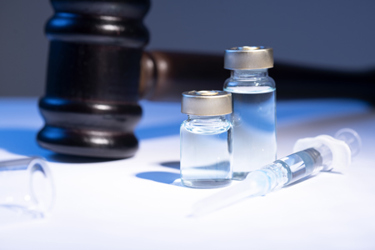Navigating The GLP-1 Litigation Landscape
By James Gourley, Partner, Carstens, Allen & Gourley

The GLP-1 drug market is booming, fueled by their success in treating diabetes and obesity. Yet, this growth has unleashed a torrent of litigation — patent disputes, regulatory battles, and clashes over compounded drugs. Understanding the legal landscape can help life science professionals rethink strategies, protect intellectual property, and adapt to a shifting regulatory landscape. This article dissects the different types of GLP-1 litigation that has occurred over the last few years, and offers actionable insights to help you safeguard your business and seize opportunities.
Compounded Drugs And FDA Shortages: A Regulatory Minefield
Until very recently, patients seeking GLP-1 drugs have seen difficulty finding brand-name versions due to shortages. Many of these patients have turned to a compounded alternative. But the makers of brand name GLP-1 drugs allege that these compounded versions do not meet rigorous safety standards. This scenario has sparked a legal firestorm between brand-name manufacturers and compounding pharmacies.
The FDA Shortage List: A Double-Edged Sword
High demand has pushed GLP-1 drugs like semaglutide and tirzepatide onto the FDA’s drug shortage list, greenlighting compounding pharmacies to produce versions of these drugs. Unlike FDA-approved drugs, compounded versions skip the same safety and efficacy reviews, but they still are required meet quality standards. As manufacturers have ramped up supply, the FDA has begun removing drugs from the list — tirzepatide in October 2024, semaglutide in 2025 — triggering fierce pushback from compounders.
Groups like the Outsourcing Facilities Association have sued the FDA, challenging the FDA’s decision to delist drugs as arbitrary. For instance, after tirzepatide’s removal, a Texas district court upheld the FDA’s stance in March 2025, though an appeal is pending.
Life science companies must monitor these designations closely. A robust supply chain can reduce reliance on compounded drugs, minimizing legal and reputational risks tied to shortages.
Lawsuits Over Safety And Trademarks
Brand-name manufacturers are also hitting compounding pharmacies with lawsuits, alleging trademark infringement (e.g., misuse of names like “Ozempic” or “Mounjaro”), consumer protection violations, and false claims of FDA approval. Any compounding pharmacy or medical practice that uses the GLP-1 brand names to advertise its product, or suggests that its product is FDA approved, is at serious risk of being on the receiving end of an expensive lawsuit.
Companies should enforce and respect trademark rights and ensure clear messaging about their products’ regulatory status to avoid consumer confusion and legal liability.
Patent Litigation: When Will Generics Be Available?
For FDA-approved drugs, patent litigation is a strategic chess match where exclusivity periods set the tempo for generic manufacturers to challenge brand-name manufacturers. For the current slate of GLP-1 drugs, timing is everything, and companies in this space must play smart to protect market share or seize generic opportunities.
Exclusivity Periods
Some GLP-1 drugs are still in the exclusivity period, while others can be challenged:
- Liraglutide: Approved in 2010 (Victoza) and 2014 (Saxenda), its exclusivity expired in 2017, and the first generic was approved by the FDA in December 2024.
- Semaglutide: Approved in 2017 (Ozempic) and 2021 (Wegovy), its new chemical entity (NCE) exclusivity ended, but new patient population (NPP) exclusivity for weight management lasts until December 2025.
- Tirzepatide: Approved in 2022 (Mounjaro) and 2024 (Zepbound), its NCE exclusivity runs to May 2027, delaying generic filings until 2026.
Brand-name firms should bolster patent portfolios now; generic players should prepare Abbreviated New Drug Applications (ANDAs) to strike when exclusivity lapses.
Lawsuit Trends: Settlements And Standoffs
Patent litigation is heating up. Novo Nordisk sued nine generic firms over semaglutide in 2022, settling on terms that likely delayed entry, and filed new suits in 2024. Tirzepatide’s battles loom as its exclusivity nears its end. These cases shape competition timelines: settlements can buy years, while unresolved suits signal prolonged fights.
The brand-name firms have so far held off on filing patent infringement lawsuits against compounding pharmacies, choosing instead to pursue trademark or safety-related claims, but the threat remains.
Review your IP strategy. Settlements might preserve market exclusivity, but aggressive enforcement could deter challengers. Generic firms and compounding pharmacies should analyze past cases to inform their go-to-market strategy.
Orange Book Risks: A New Battleground
The Federal Trade Commission (FTC) is scrutinizing Orange Book listings, targeting patents that may delay generics. In December 2025, the Teva v. Amneal ruling forced delisting of device patents not tied to active ingredients — a precedent that could hit GLP-1 drugs with complex delivery systems.
Audit your Orange Book listings now. Improper listings invite FTC action or competitor challenges, accelerating generic entry and eroding market position.
ITC Complaints: Fast-Track IP Enforcement
The International Trade Commission (ITC) offers a turbocharged alternative to sluggish district courts, resolving cases in 12–18 months with potent remedies like exclusion orders. For GLP-1 firms, it’s a game changer.
Eli Lilly’s Play: Targeting Compounded Imports
Eli Lilly’s ITC complaint against online pharmacies selling compounded tirzepatide is a prime example. Filed over trademark misuse and unapproved drug imports, the case saw an Administrative Law Judge recommend a general exclusion order in December 2024 banning all infringing tirzepatide imports.
The speed and scope of ITC proceedings make them a go-to for combating widespread infringement in imported products. If you’re facing multiple infringing importers, consider this venue to protect your market.
Future Trends: Anticipating The Next Wave
As GLP-1 exclusivity periods fade, generics will come in, and litigation will evolve. Life science professionals must look ahead to stay competitive.
Beyond Patents: New Legal Frontiers
Expect a shift beyond patent fights:
- Product Liability: Rising use could spark claims over side effects or labeling. Ensure compliance in marketing and warnings.
- Compounding Patent Suits: Brand-name firms may pivot to patent claims against compounders as other disputes resolve.
- Pricing Battles: High costs could trigger antitrust or reimbursement disputes with payers.
Proactively address these risks — strengthen labeling, perform due diligence around applicable intellectual property, and monitor pricing policies.
Conclusion: Act Now Or Fall Behind
The GLP-1 litigation boom isn’t slowing down. From compounded drugs to trademarks and patents, the stakes are high for life science professionals. Take note of the legal landscape when planning future actions in this area. Audit your IP, rethink your legal strategies, and brace for regulatory shifts.
About The Author:
 James Gourley, partner at Carstens, Allen & Gourley, has successfully obtained federally registered patents, trademarks, and copyrights, and understands the significance of intellectual property rights as vital assets for companies. He has built strong IP portfolios, negotiated licensing and employment agreements, and provided due diligence for corporate mergers and acquisitions. Notably, he served as lead defense counsel in a landmark patent infringement lawsuit on cannabis formulations.
James Gourley, partner at Carstens, Allen & Gourley, has successfully obtained federally registered patents, trademarks, and copyrights, and understands the significance of intellectual property rights as vital assets for companies. He has built strong IP portfolios, negotiated licensing and employment agreements, and provided due diligence for corporate mergers and acquisitions. Notably, he served as lead defense counsel in a landmark patent infringement lawsuit on cannabis formulations.
A registered patent attorney with the United States Patent and Trademark Office, James served on the Board of the Dallas Bar Association's Intellectual Property Section before moving to Denver. He is a member of the State Bar of Texas and Colorado and is admitted to practice in the U.S. District Courts for the Northern, Southern, Eastern, and Western Districts of Texas, the District of Colorado, the Fifth Circuit Court of Appeals, and the United States Supreme Court.
